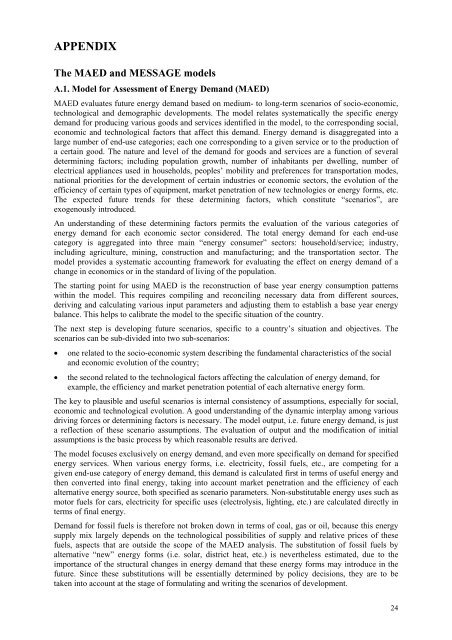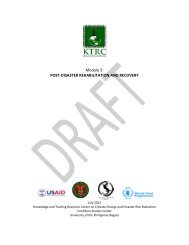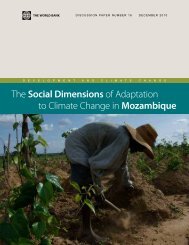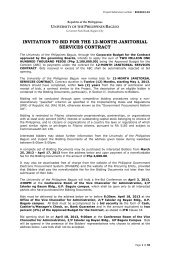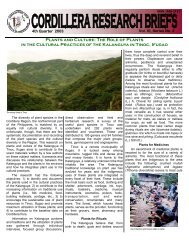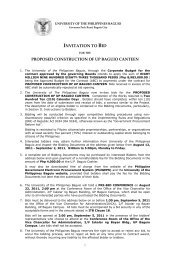Ghana - UNEP
Ghana - UNEP
Ghana - UNEP
- No tags were found...
Create successful ePaper yourself
Turn your PDF publications into a flip-book with our unique Google optimized e-Paper software.
APPENDIXThe MAED and MESSAGE modelsA.1. Model for Assessment of Energy Demand (MAED)MAED evaluates future energy demand based on medium- to long-term scenarios of socio-economic,technological and demographic developments. The model relates systematically the specific energydemand for producing various goods and services identified in the model, to the corresponding social,economic and technological factors that affect this demand. Energy demand is disaggregated into alarge number of end-use categories; each one corresponding to a given service or to the production ofa certain good. The nature and level of the demand for goods and services are a function of severaldetermining factors; including population growth, number of inhabitants per dwelling, number ofelectrical appliances used in households, peoples’ mobility and preferences for transportation modes,national priorities for the development of certain industries or economic sectors, the evolution of theefficiency of certain types of equipment, market penetration of new technologies or energy forms, etc.The expected future trends for these determining factors, which constitute “scenarios”, areexogenously introduced.An understanding of these determining factors permits the evaluation of the various categories ofenergy demand for each economic sector considered. The total energy demand for each end-usecategory is aggregated into three main “energy consumer” sectors: household/service; industry,including agriculture, mining, construction and manufacturing; and the transportation sector. Themodel provides a systematic accounting framework for evaluating the effect on energy demand of achange in economics or in the standard of living of the population.The starting point for using MAED is the reconstruction of base year energy consumption patternswithin the model. This requires compiling and reconciling necessary data from different sources,deriving and calculating various input parameters and adjusting them to establish a base year energybalance. This helps to calibrate the model to the specific situation of the country.The next step is developing future scenarios, specific to a country’s situation and objectives. Thescenarios can be sub-divided into two sub-scenarios:• one related to the socio-economic system describing the fundamental characteristics of the socialand economic evolution of the country;• the second related to the technological factors affecting the calculation of energy demand, forexample, the efficiency and market penetration potential of each alternative energy form.The key to plausible and useful scenarios is internal consistency of assumptions, especially for social,economic and technological evolution. A good understanding of the dynamic interplay among variousdriving forces or determining factors is necessary. The model output, i.e. future energy demand, is justa reflection of these scenario assumptions. The evaluation of output and the modification of initialassumptions is the basic process by which reasonable results are derived.The model focuses exclusively on energy demand, and even more specifically on demand for specifiedenergy services. When various energy forms, i.e. electricity, fossil fuels, etc., are competing for agiven end-use category of energy demand, this demand is calculated first in terms of useful energy andthen converted into final energy, taking into account market penetration and the efficiency of eachalternative energy source, both specified as scenario parameters. Non-substitutable energy uses such asmotor fuels for cars, electricity for specific uses (electrolysis, lighting, etc.) are calculated directly interms of final energy.Demand for fossil fuels is therefore not broken down in terms of coal, gas or oil, because this energysupply mix largely depends on the technological possibilities of supply and relative prices of thesefuels, aspects that are outside the scope of the MAED analysis. The substitution of fossil fuels byalternative “new” energy forms (i.e. solar, district heat, etc.) is nevertheless estimated, due to theimportance of the structural changes in energy demand that these energy forms may introduce in thefuture. Since these substitutions will be essentially determined by policy decisions, they are to betaken into account at the stage of formulating and writing the scenarios of development.24


